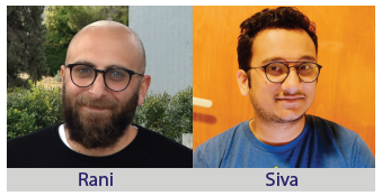SPOTLIGHT ON RESEARCH
Paper of the month /March 2022
We are pleased to announce that the winners of the MARCH article are the doctoral students Mangapuram Venkata Sivasubramanyan and Zananiri Rani from Prof. Henn and Kaplan Labs, whose article was published in Nature Communications.
On the occasion of the win, we asked them to provide us with some interesting details about the study, the path that led to the research and also a bit about themselves.
*Could you please introduce yourself in a few words?
Rani: My name is Rani, I am a 2018 Ph.D. Graduate from the faculty. Previously, I obtained degrees in Electrical and Biomedical Engineering. Since graduation, I joined GE Healthcare, where today, I work as a Senior Physicist.
Siva: I am Sivasubramanyan M V (Siva), originally from Chennai, Tamil Nadu, India. During my 11th-grade summer vacation, I did a 2-month-long research project in the biochemistry lab of Dr.P.Gautam (Anna University, Chennai). This kindled in me an interest in further pursuing chemistry and biology. I did my bachelor’s in chemistry and realized that my main interest was in physical chemistry due to its quantitative nature. So, my master’s was in physical chemistry. Meanwhile my efforts to learn biology by reading textbooks and doing summer research internships in biochemistry labs, eventually led me to Arnon’s lab to pursue my Ph.D. in biochemistry/biophysics. I graduated from Technion in 2020.
*Could you explain what Prof. Kaplan/Henn’s laboratory is about?
Although the specific problems that the Kaplan and Henn labs work on are different, both labs combine principles and techniques from physical chemistry/ physics to study biologically relevant molecules. Currently, the Henn lab focuses on understanding the mechanisms of molecular motors (helicases and myosins), while the Kaplan lab’s focus is on nucleosomes and their role in transcriptional regulation.
*The article is a mutual work of 2 labs. Could you explain the current article/research and what was the main purpose behind the research, and how the cooperation between 2 labs contributed to the research?
We started with an aim to understand the mechanisms behind the outstanding rate and efficiency of RecBCD is a DNA helicase. To investigate this, we approached the questions with a variety of tools available in both labs. The ability to study the proteins working at the ensemble (with Henn lab’s specialization in biochemistry and bulk biophysics) as well as the single-molecule level (Kaplan’s lab), enabled us to test our hypothesis comprehensively and arrive at a mechanism. The collaboration with Dr. Oded Kleifeld (Faculty of Biology, Technion) was crucial and noteworthy!
*Can you elaborate on the importance of the discovery? How will it serve you, and which directions/ applications (domains, solutions) will it open?
Based on our findings we have proposed a mechanism by which auxiliary ATP binding sites in the helicase can serve as a funnel to bind and transfer ATP molecules to the catalytic center of the enzyme. This could turn out to be a more general feature of other helicases. Also, our discovery brings new knowledge about a previously unknown role of the RecC subunit of the RecBCD enzyme.
*What drew you to the current lab/project?
Rani: Coming from an engineering background, I have always been attracted to reverse engineering – looking at a working system and drawing basic engineering principles enabling it to perform its job. Biological systems are the most attractive systems we currently know; efficient, and robust.
Siva: As I had earlier mentioned, with my interest in both physical chemistry as well as biology, I was looking to work in a lab that combined techniques and principles from both areas. Arnon Henn’s lab suited my interests aptly.
*When you are not “doing” science, what do you do?
Rani: I like to spend my free time learning code and Arabic calligraphy. Here is an example.
Siva: I am an avid reader and enjoy discussing and sharing my opinions about literature through podcasts. Photography also is a hobby I practice.
*what are your plans for the future of your career?
Rani: Four years into the industry, I have learned that as opposed to the common misconception regarding the industry, there are very attractive positions that require a lot of innovation, problem-solving, and imagination; tools that are well acquired during the Ph.D.
Siva: I am currently a postdoctoral fellow at Caltech, USA, working on the co-translational folding problem. The goal is to stay curious and passionate about science and eventually be able to practice it by heading my own lab.
A link to Kaplan lab site: https://kaplan.net.technion.ac.il/
A link to Henn lab: https://hennlab.net.technion.ac.il/
To prof. Kaplan page: https://biology.technion.ac.il/en/member/kaplan/
To prof. Henn page: https://biology.technion.ac.il/en/member/chen/








